The Motorola Moto G4 and G4 Plus Review
by Brandon Chester on August 15, 2016 8:00 AM EST- Posted in
- Smartphones
- Lenovo
- Motorola
- Moto G
- Moto G4
GPU Performance
As I mentioned on the last page, moving from Snapdragon 410 to Snapdragon 617 doesn't really lead to a significant improvement in real-world CPU performance. What does improve is GPU performance, which is something that has always been a bit of a problem on low-end and mid-range smartphones. The 2015 Moto G used Qualcomm's Snapdragon 410 SoC. Snapdragon 410 uses Qualcomm's Adreno 306 GPU, which put the 2015 Moto G in a bit of an odd position because that same SoC was used in the significantly cheaper Moto E. Snapdragon 617 uses Adreno 405, which we've demonstrated as providing significantly faster performance than Adreno 306 in past reviews of other devices that use it. It's worth testing a device to ensure everything is working correctly even if you already have results for another device with the same SoC, and so I've run our 2016 GPU benchmarks on the Moto G4.
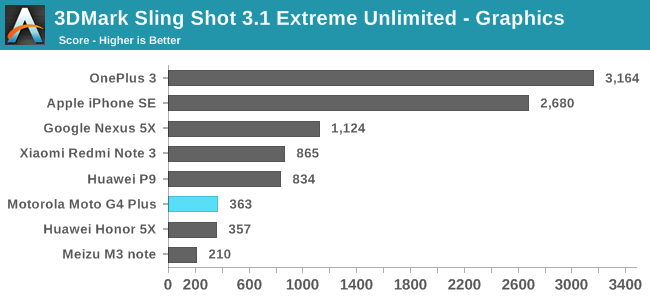
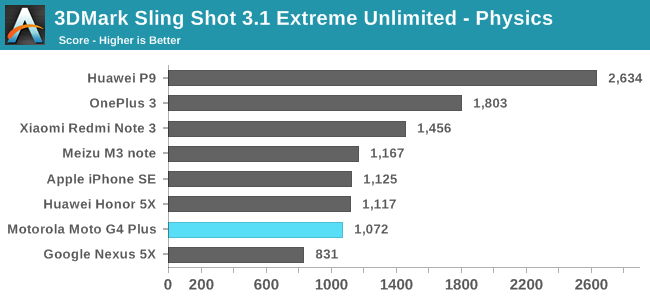
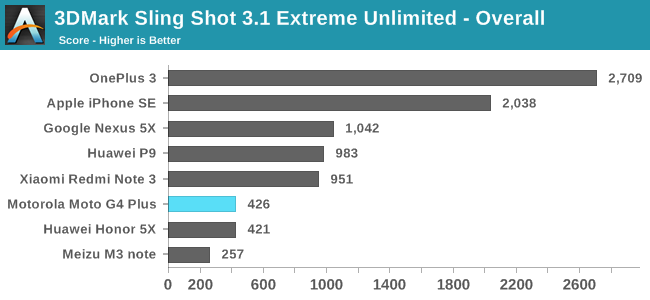
The 2015 Moto G doesn't support OpenGL ES 3.1, and so there's no way to run 3DMark Sling Shot Extreme Unlimited which uses ES 3.1 on Android and Metal on iOS. Snapdragon 617 uses the same Adreno 405 GPU as Snapdragon 615, and you can see in the results that the performance is right in line with the Huawei Honor 5X which uses Snapdragon 615. For a mid-range phone this is generally good performance, but once again the Xiaomi Redmi Note 3 sits far ahead of the rest of the mid-range smartphones, including the Moto G4.
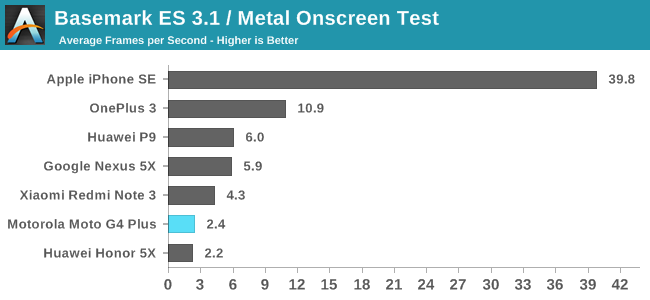
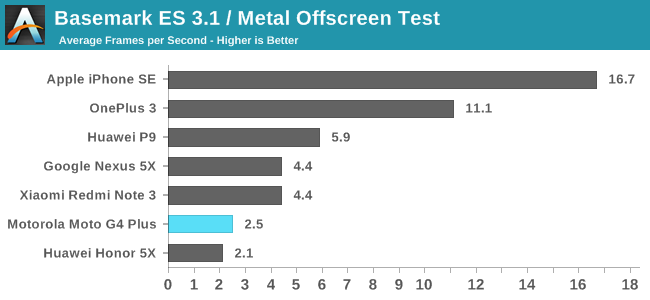
The situation in BaseMark ES 3.1 is the same as 3DMark, with the G4 Plus achieving roughly the same performance as the Huawei Honor 5X. The Xiaomi Redmi Note 3 with its Adreno 510 GPU ends up being a little over 75% faster, which is a huge improvement even if both devices technically don't get close to a playable frame rate in this very heavy test.
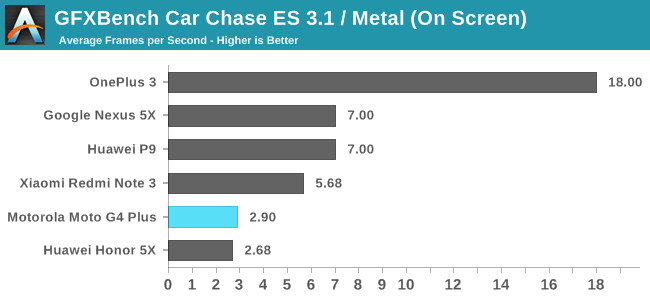
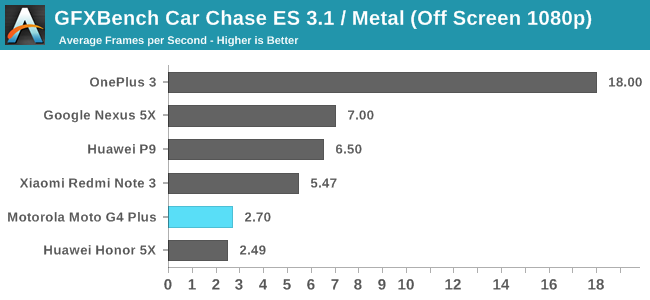
In GFXBench Car Chase it's the story is the same. The Moto G4 Plus is in line with other Adreno 405 devices, but the question is really whether or not that's good enough for a device launching this late into 2016.
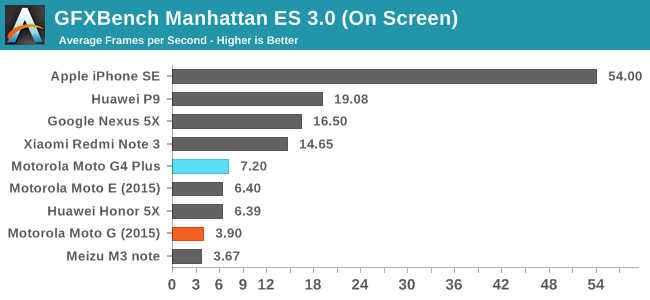
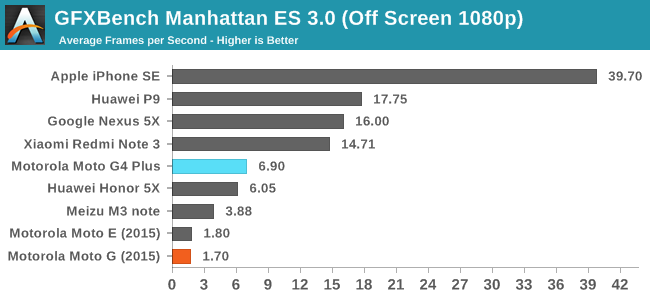
We've generally moved to Manhattan ES 3.1 / Metal for our reviews, but in cases like this where a device's predecessor doesn't support OpenGL ES 3.1 it's helpful to bring back Manhattan ES 3.0 to do a direct performance comparison. As expected, the Moto G4 is much faster than the 2015 Moto G, with on screen performance being about 85% faster despite the move from 720p to 1080p. and off screen performance being over four times faster.
It's clear that the Moto G4 provides much better GPU performance that the 2015 Moto G. However, much like the CPU benchmarks, I keep looking at the charts and seeing the Xiaomi Redmi Note 3 sitting well above the Moto G4. Adreno 405 is much better than Adreno 306, but Adreno 510 is two times faster than Adreno 405. I feel like the Moto G4 is simply launching too late for this kind of performance to be competitive, as it's tied with the Honor 5X which was launched at $200 nearly a year ago. While I don't mean to take away from the fact that the Moto G4 does provide faster GPU performance than its predecessor, I think there are devices right around the corner that are going to make a mid-range smartphone with Snapdragon 617 look decidedly last generation.
NAND Performance
NAND performance is still an area of concern on mid-range smartphones, but the situation has gotten better in recent times. The 2015 Moto E was an example of a device with very poor NAND performance, but the 2015 Moto G was significantly faster across the board. Motorola is still using eMMC memory, but there's definitely room for improvement over the 2015 Moto G even when sticking with an eMMC storage solution. To evaluate the Moto G4's storage performance I've run AndroBench 4.0 on both the 16GB Moto G4 and the 64GB Moto G4 Plus.
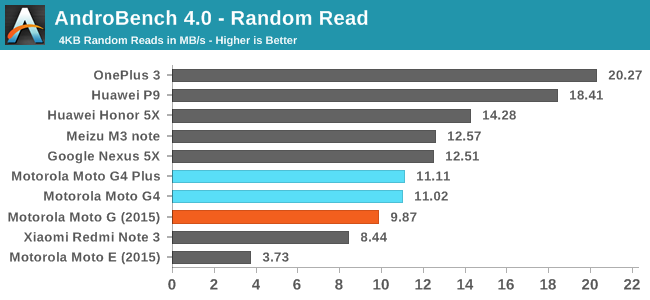
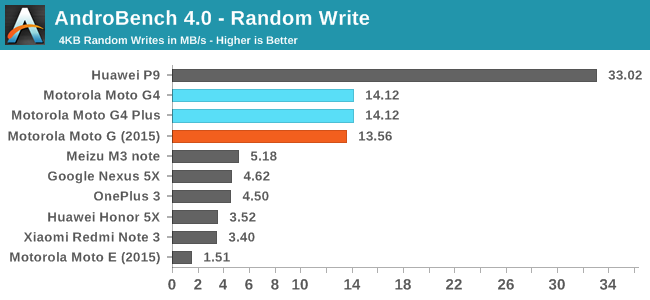
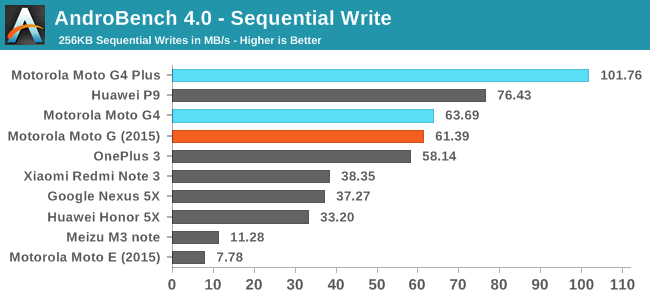

Among mid-range devices, the 64GB Moto G4 Plus performs very well. Random write results are ahead of all other devices on the chart except the Huawei P9, which isn't really a mid-range device and is just there for SoC comparisons. In the sequential write test the Moto G4 leads, which is due in part to the larger capacity allowing greater write parallelism. Sequential read performance is very good as well, although obviously not competitive with UFS 2.0 storage solutions like the one used in the OnePlus 3.










94 Comments
View All Comments
stardude82 - Tuesday, August 16, 2016 - link
Well, I picked up a Moto G4 for $125 and the Moto G4 Plus has features which the 5X doesn't have. The Nexus 5X is not that much better of a phone in my opinion and the lack of SD slot is a deal breaker for many.Cod3rror - Monday, August 15, 2016 - link
I have to say the camera on G4 Plus is very impressive in daylight pictures. I like to pixel peep and I think G4 Plus was the best out of the bunch. OP3 looks great, but if you look at the images at 100%, they look oil painted, especially the vegetation. Either the camera technology has plateau-ed or lower end devices are really upping their game in this area.Did you experience any ghost touch issues? Motorola forums are riddled with complaints about ghost touch issues with G3s and G4s.
It's disappointing to read about the jittery UI, Moto G3 is smooth (we're talking by Android standard here) and fast.
I think in general Motorola has been going downwards after Lenovo purchased them. They had issues with G3 screens with ghost touching as mentioned (build quality and design is awesome though), they clearly slacked on G4, have the same screen issues and overpriced it too (at that price, it should've been SD650).
Brandon Chester - Monday, August 15, 2016 - link
I really haven't had any issues with ghost touches or overheating or anything like that. I was playing Pokémon Go which is a relatively intensive game (partially due to terrible design) and the phone was working fine. My main issue has just been the generally poor performance.archaicertes - Tuesday, August 16, 2016 - link
I noticed ghost touch days after I bought it. Not just while charging. I returned it because they wanted us to send it in for repair and wouldn't share the solution.WPX00 - Tuesday, August 16, 2016 - link
The camera should be impressive. The OV16860 is a part meant for FLAGSHIP phones, not $250 devices. Put OIS in it and a nicer quality lens and I would be quite happy to see it on a high end LG or Nexus. OIS sometimes makes all the difference: remember the $624 Moto Z uses the same sensor as the $149 Moto G4 Amazon Edition, but with OIS and a faster lens, making it a better camera than the $249 Moto G4 Plus which in theory has a better sensor part.Sumedh - Monday, August 15, 2016 - link
I have been using g4 plus for 2 months and i would like to point out the heating problem in it ..it gets too hot while playing games and also starts lagging while charging ..and camera slows down if you use it for more than 15minssinsin - Monday, August 15, 2016 - link
One of the saddest parts is that Moto/Lenovo has put the same camera sensor (as Moto G4, Moto G 2015, Nexus 6 (2014)) on it's newest flagship Moto Z (2016).TheinsanegamerN - Monday, August 15, 2016 - link
these would be good phones if they were not made by lenovo, a company that cannot be trusted with privacy and has already confirmed they will not be providing regular updates.markiz - Monday, August 15, 2016 - link
Brandon, you mentioned a few times here that you find larger screens as having a negative impact on usability?Seeing as how I am of the opposite conviction (or have a wrong understanding of the word usability) I though it would be a good idea to explore in an article. How does smartphone screen size affect usage.
For example me, I could not care less for one handed usage, nor can i understand why would anyone care, so it would be interested to understand why.
Pissedoffyouth - Wednesday, August 17, 2016 - link
I could see on a crowded subway one handed use being popular